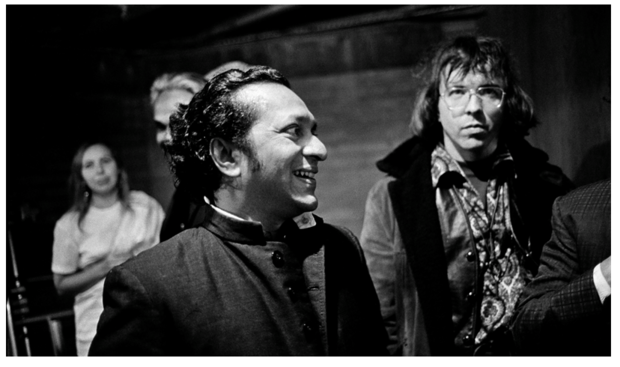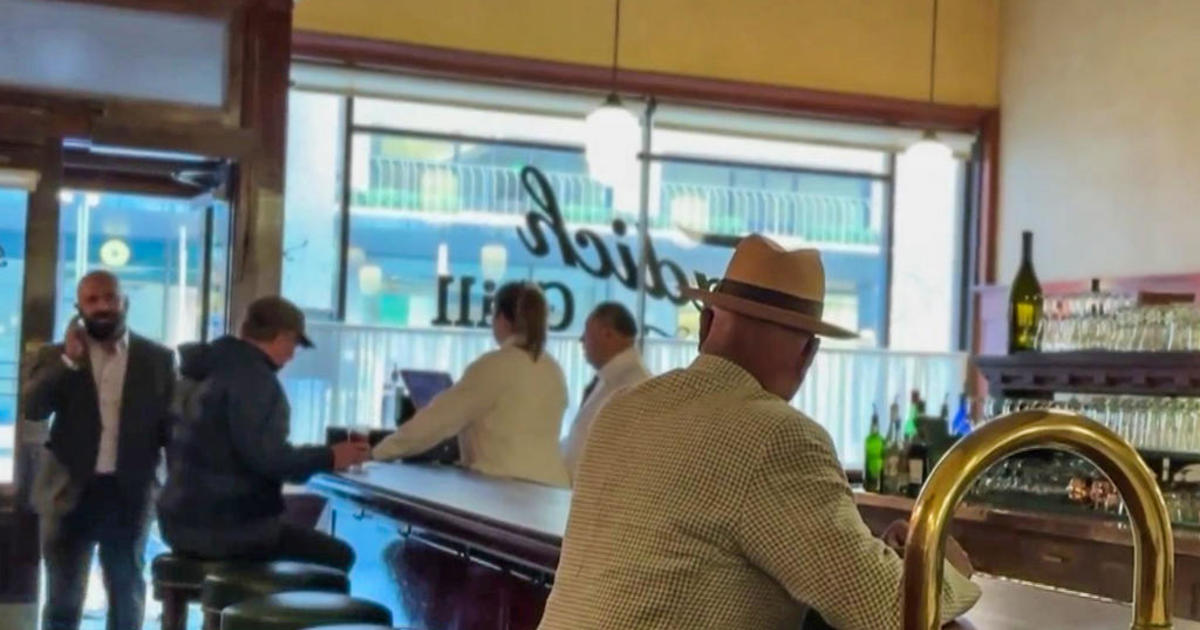Repair Of Iconic '60s Era Synthesizer Turns Into Long, Strange Trip For Engineer
by Juliette Goodrich and Molly McCrea
SAN FRANCISCO (KPIX 5) -- For years, an urban legend circulated online and in documentaries purporting how part of a groundbreaking musical instrument -- versions which are stored at a Bay Area university and other institutions -- was dipped in LSD.
Online chatter detailed how musicians who used the instrument would wet their finger, touch the device, and then lick their finger to get a little bit of mind-expanding inspiration.
Now this supposed myth may turn out to be a reality.
---
At the helm of KPIX Television, Broadcast Operations Manager Eliot Curtis tackles all sorts of technical problems to keep Channel 5 on the air. Recently however, a strange electrical transmission threw him for a loop. It happened inside his brain.
"It was ... felt like I was tripping on LSD," remarked Curtis.
It turns out that Curtis was indeed tripping on the infamous psychedelic drug known as lysergic acid diethylamide, or LSD for short. He got dosed by accident at home in his workshop -- in front of his wife.
"I think it's super wild. I think this whole situation is a nice chapter in the history of the counter culture," commented Curtis' wife Holly.
ALSO READ: Famed Bay Area Rock Photographer Jim Marshall Featured In New Documentary
Late last year, Eliot volunteered to fix a vintage "analog music modular instrument" owned by the music department at Cal State University East Bay.
The instrument -- commonly known today as a synthesizer -- was acquired from the university by two leading avant-garde musicians who taught in the music department in the '60s. Cal State East Bay was then known as Cal State Hayward. The men who secured the funding were Professors Glenn Glasow and Robert Basart, two men were at the forefront of the burgeoning Bay Area modern music scene. Both men have since passed away.
"It's definitely a piece of history," commented musician Joel Davel.
"Yeah, [they were] looking for new ways of creating sound," explained Ines Thiebaut, Assistant Professor of Music at Cal State East Bay.
WEB EXTRA VIDEO: Buchla Model 100 Synthesizer at Cal State University East Bay
But the modular analog synthesizer device eventually fell out of favor, into disrepair and was stored in a cool, dark place for decades.
"It was in a closet in the corner of a classroom, which was a little sad because it was like a shipwreck," remarked music composer and retired professor William R. Shannon, who remembers composing on the device when he was a student.
At one point, the device was likely augmented with additional modules, including a red-colored module on the top row. During his repair work, Curtis opened the module and saw something stuck under a knob.
"There was like a residue ... a crust or a crystalline residue on it," said Curtis.
ALSO READ: Nearly 14,000 Attend 'Mellow' 4/20 Celebration in San Francisco Golden Gate Park
He sprayed a cleaning solvent on it and started to push the dissolving crystal with his finger as he attempted to dislodge the residue and clean the area.
About 45 minutes later, Curtis began to feel a little strange. He described it as a weird, tingling sensation. He discovered this was the feeling of the beginnings of an LSD experience or trip.
The sensation lasted roughly nine hours.
Three individual chemical tests identified the substance as LSD. A well-known LSD researcher and expert who asked to remain anonymous told KPIX that LSD can remain potent for decades if kept in a cool, dark place.
The expert also informed KPIX that one can ingest the chemical through the skin under the right conditions. He noted that the Swiss scientist Albert Hofmann, who was the first person to synthesize and ingest LSD, wrote in his memoirs that he believed he accidentally ingested the drug through his skin.
It turns out this machine has deep roots to the west coast counterculture. It's called a Buchla Model 100, and it was created by the late Don Buchla of Berkeley.
Buchla was by all accounts a genius. In 1959, he earned a bachelor's degree in physics from the University of California at Berkeley where he also studied physiology and music. As a grad student, he worked at the Lawrence Berkeley National Laboratory. There, Buchla built klystrons. A klystron is a specialized linear-beam vacuum tube that is used to amplify high radio frequencies. He was also experimenting with a type of music composition known as "musique concrète" that uses recorded sounds to create music.
It was during this time, that Buchla encountered two giants in the electronic music field: composers Morton Subotnick and Ramon Sender. A book entitled "The San Francisco Tape Music Center: 1960s Counterculture and the Avant-Garde" which was edited by David W. Bernstein, contains a treasure trove of interviews and detailed information. In 1962, Subotnick, Sender, and Pauline Oliveros established a nonprofit cultural and educational organization known as the San Francisco Tape Music Center. The Center was a huge part of the exciting avant-garde artistic scene.
Magnetic recording tape was invented for recording sound in 1928 in Germany. This key technology revolutionized recording, sound reproduction, and broadcasting; and the Center offered a place to learn about the medium as well as other new art forms involving electronics.
Subotnick and Sender were seeking an engineer who could create a "composer's box" to create a new kind of music: electronic music. Subotnick had many one-on-one discussions with Buchla on what he wanted. He wanted a way to move and manipulate frequencies. The Center then commissioned Buchla to create a system. This original commission led to the invention of the innovative voltage-controlled Buchla
Buchla himself said he began to work on the modular system in 1963, one module at a time. The newly invented system is believed to have arrived at the center by late 1964 or early 1965. In 1967, Subotnick released the first piece of electronic music ever commissioned by a record company. "Silver Apples of the Moon," released by Nonesuch/Elecktra Records, was a surprise success, and showcased the Buchla synthesizer. The original Buchla is now found at Mills College in Oakland.
From this original invention, the Buchla model 100 series emerged. Davel informed KPIX News that it is believed that there were about 20 early Buchla systems sold before Cal State East Bay acquired its Buchla, apparently in 1968. Each module in the system had different functions. Davel said it arrived with two 30-panel cabinets and then at a later point, a third cabinet was added. It is believed by some that the red module appeared around this time.
"I call him the Leonardo Da Vinci of electronic music design." remarked Suzanne Ciani, known as the "Diva of the Diode" and an acknowledged pioneer in electronic music. Ciani worked with Buchla in the late '60s and '70s when she was a grad student at University of California, Berkeley.
Ciani recalled how the Buchla 100 was developed in the 60s when Berkeley was the epicenter of political and social unrest.
"It's no accident that he developed his unique ideas in this crucible of upset and chaos in Berkeley," noted Ciani.
WEB EXTRA VIDEO: Who was Don Buchla?
ALSO READ: 'Cannabis Is Plentiful' – KPIX 5 Reporter Torches Trail Blazer Fan's Hot Take On Warriors Series
In 1966, some Buchla modules ended up on an old school bus purchased by LSD advocate Ken Kesey and his followers known as the Merry Pranksters.
During the last of Kesey's acid tests -- LSD-fueled parties -- at Winterland on Halloween in 1966, electronic sounds, possibly from the Buchla, appeared to interrupt an interview of Kesey.
Buchla used LSD and was friends with Owsley Stanley, the genius behind the Grateful Dead's sound system. Stanley, also known as Bear, was a masterful sound engineer and legendary hero of the counterculture. He was also famous for making the purest LSD to ever hit the street and kept such a low profile that not many photos of him exist.
ALSO READ: CBS SF Talks To 'Murder In The Front Row' Thrash-Metal Doc Director Adam Dubin
Author/photographer Rosie McGee, who had uncommon access to the Dead, managed to capture a photograph of the elusive Stanley in 1968. McGee and her intimate, early-days portraits of the band are historic and revealing. Her personal memoir "Dancing with the Dead - A Photographic Memoir" sheds light on the San Francisco Music Scene of the 60s and early 70s, and provides context and detail to the era in which Buchla and Stanley lived.
Another picture of Owsley taken by legendary photographer Jim Marshall captured him at the 1967 Monterey Pop Festival which helped usher in what would be called the "Summer of Love." In this rare photo, Owsley is seen behind the influential Indian musician and sitar virtuoso Ravi Shankar.
As to how the LSD ended up on the red modules?
"There were a lot of legends," said Davel, who worked for Buchla for more than 20 years and is now the lead designer and engineer for Buchla USA.
There are few facts available to come to an understanding of why LSD ended up on the red module handled by the KPIX engineer. Buchla and Stanley are both dead and no public records exist to shed any light as to where the modules originated. On the Buchla 100 at Cal State East Bay, some modules were added and did not come with the first order. Close friends tell conflicting and confusing stories.
Was the red module used to stash the drug? Did an accidental spill result in the drug seeping through to the circuitry or was it a source for chemically-induced and mind-altering inspiration?
No one knows. Even so, Ciani said what happened to Curtis is astonishing.
"It's a bit like time travel," said Ciani. "If you could go back that would be the way to go there. That is, to share the drugs that everybody took at that time."
WEB EXTRA VIDEO: Digital vs. Analog
After his strange trip, Curtis -- wearing gloves -- finished repairing the vintage Buchla. The instrument is now back at Cal State East Bay and ready for music students to explore.
The device has no keyboard. You play it by turning knobs and patching cords. It can move sound around a room. The students on hand were mesmerized. Some told us that they were blown away by its design and craftsmanship .
"This will open your mind, you know?" said CSUEB student Adam Hughes, laughing. "Sometimes I think the LSD will open your mind too."
One final note: there will be no more trips with this Buchla. The instrument has been thoroughly cleaned of all LSD.





